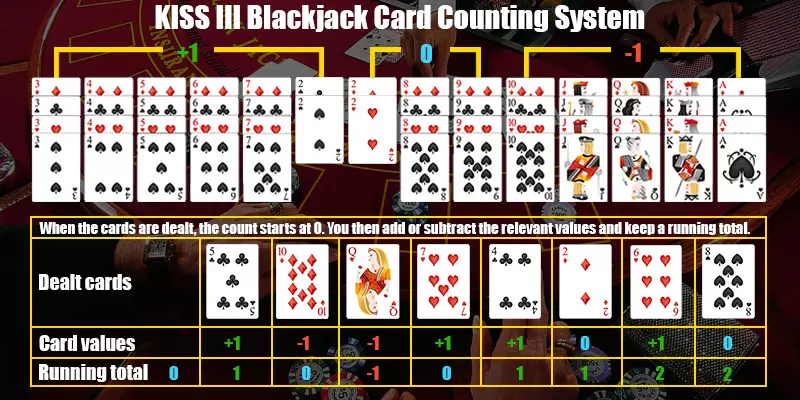Card counting is one of the most widespread strategies, as it is extremely efficient and accurate when applied correctly. As Blackjack is a casino game that can be beaten by using a reliable strategy and the appropriate skills, it has become one of the most played games of all time. Over the years, many professional gamblers have developed a number of different methods in order to increase their chances of winning and gain an advantage over the casino.
Players can benefit greatly from them, but only if they invest a great deal of effort and time into learning how to apply them efficiently. It is also essential to have discipline, money-management skills and solid knowledge of the basic strategy. This is the only way they will be able to achieve the desired results and improve their game.
One card counting system that is growing increasingly popular is the so-called KISS system (Keep It Short and Simple). This method has been improved and developed several times, resulting in two additional variations – KISS II and KISS III. They are all designed to be very easy to learn and understand, and their simplicity makes them perfect for beginners. Although they are relatively simple, their level of efficiency is high, and each update has been a step in the right direction.
Brief History
The book Blackjack Bluebook II – The Simplest Winning Strategies Ever Published, written by Fred Renzey, is one of the reasons why the KISS systems are so well-known among Blackjack players. They give players the opportunity to use a card counting strategy that is both simple and efficient. Their counting principles differ from those of most other popular methods, which makes them worth getting to know.
Differences between the KISS Systems
All of the KISS systems are unbalanced, which is good news for many players who struggle to convert the running count into a true count. The main difference between them is the level of advantage they provide. KISS I was created first and, therefore, offers the smallest edge. Over the years, its updated versions, KISS II and KISS III, have been developed to help players make better decisions and, more importantly, to give them a greater chance of gaining an advantage over the casino. This is why the initial system is now seldom used, as superior versions are available.
Card Counting Systems
Hi-Lo System
Red Seven System
K-O System
KISS Systems
KISS (I) System
The KISS I, or simply KISS, is a level-one system, as it is significantly simplified compared with other card counting systems. As already mentioned, its main principle is unusual because, instead of assigning point values to every card rank, it omits half of the cards in the deck. In this way, players do not have to remember so many assigned values or keep track of as many cards.
This also greatly reduces the chance of confusion while keeping track of the cards and, thus, is easier to apply in a casino setting. However, as already mentioned, the initial system is rarely used nowadays, as it is deemed unable to provide sufficient advantage for players. It is simply regarded as the foundation of KISS II and KISS III, and it is best to learn the updated versions instead. They are definitely worth trying, and players should take their time to study their patterns.
| KISS (I) Card Counting System | |
|---|---|
| Card Value | Count |
| 4, 5, 6 | count +1 |
| A, 2, 3, 7, 8, 9 | count 0 |
| 10, J, Q, K | count -1 |
KISS II System
The KISS II system remains moderately easy, but it significantly improves players’ chances of gaining an advantage over the casino and, therefore, enables better decisions regarding their moves and bets. It is also a level-one system and, due to its simplicity, works best when the game is played with a single deck.
The point values assigned in this system are as follows: tens and all face cards are -1; cards from three through six are +1; the remaining cards are 0, except for the black two. This subtlety requires special attention, as the twos are counted according to their colour – the black two is +1, while the red two is 0. Players should take their time and remember this detail.
| KISS (II) Card Counting System | |
|---|---|
| Card Value | Count |
| 3, 4, 5, 6 | count +1 |
| 2 black | count +1 |
| 2 red | count 0 |
| A, 7, 8, 9 | count 0 |
| 10, J, Q, K | count -1 |
KISS III System
This is the latest variation of the KISS system and is designed to meet current players’ needs, taking into consideration modern trends in most casinos. It is no secret that it is very hard to find a table where Blackjack is played with only one deck, as many casinos realise that this helps card counters keep track of the cards and gain an advantage more easily. In contrast to KISS II, KISS III is suitable for games that use multiple decks, as its scheme is a bit more complicated. This time, more cards have assigned values in order to provide the necessary accuracy.
The point values in this strategy are as follows: the tens, face cards and the ace are -1. Cards from three through six are +1, and this time the seven also joins this group. The remainder of the scheme mirrors KISS II – the black two is +1 and all other cards are 0.
| KISS (III) Card Counting System | |
|---|---|
| Card Value | Count |
| 3, 4, 5, 6, 7 | count +1 |
| 2 black | count +1 |
| 2 red | count 0 |
| 8, 9 | count 0 |
| 10, J, Q, K, A | count -1 |
Benefits of the KISS III System
Understandably, this system is considered the best of all the KISS variants, as it gives players the greatest chance of gaining an advantage over the casino and winning. Its betting correlation, in other words its efficiency at giving players an edge over the casino, is 0.98. This alone indicates that the version has everything needed to compete with other high-class card counting systems. Thanks to this, players can adjust their bets accordingly, minimise losses and, at the same time, take advantage of situations in which they are in a favourable position.

Conclusion
The KISS systems are impressive because they provide players with a plan that is both efficient and simple. Not many card-counting systems achieve this remarkable combination, as most need to be very complicated in order to be accurate. KISS II and KISS III are easy to grasp and can therefore be applied whenever needed. For this reason, they are suitable for beginners who want to improve their performance at the table. However, even though they are significantly simplified, players need to bear in mind that they still require a great deal of practice and effort if they want to make them work.



